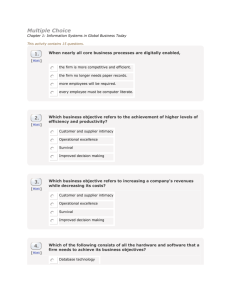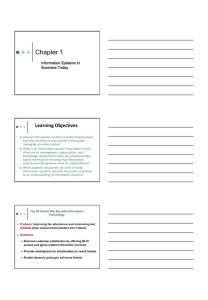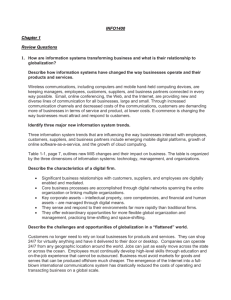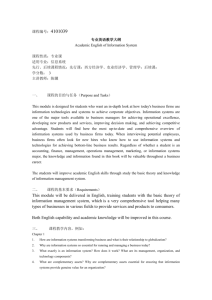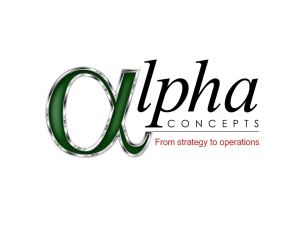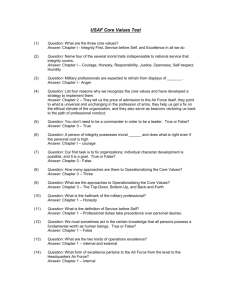Lecture 2
advertisement
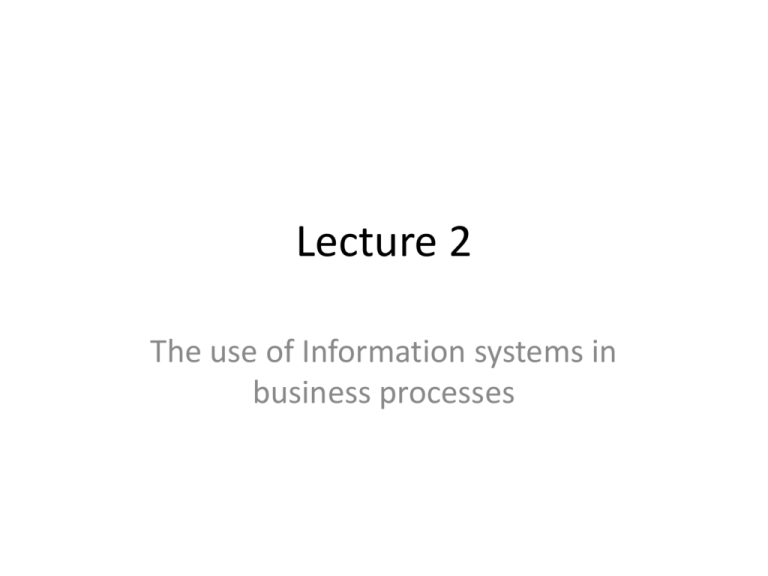
Lecture 2 The use of Information systems in business processes The Organisation Organisational Problem Organisational Level Strategic Senior Management General or Middle Management Tactical Knowledge or Data Workers Knowledge Operations Production Workers P ro duct io n Fin an ce/ Sales/ Hum an acco un t in g m ark et in g Reso urces A business process • A business process is a set of logically related tasks & behaviors that organization develop to produce specific business results and the manner in which these activities are organized and coordinated. • ” these activities are designed to produce a specific output for a particular customer or market” and give the firm a competitive advantage in order to generate revenue. 3 Some core Business Processes • Sales/Marketing: – Customer Strategy & Relationships (Marketing) – Customer Acquisition (Sales) • Finance and accounting – Financial Analysis, Reporting, & Capital Management – Management Responsibility – Accounting Management Some core business processes • H.R. – Employee Development & Satisfaction • Production – Product Development – Product/Service Delivery • Technology Management The Digital Firm • A company/organisation/firm in which all business process with customers, suppliers and employees are digitally “managed”. • Corporate assets: intellectual property and core competencies (activities and resources that could give a competitive advantage), financial and human assets are digitally managed. • These firms sense and respond to environmental changes rapidly as any information is available anytime and anywhere. 6 The digital firm • Two implications are: – Time shifting refers to business being conducted continuously, 24x7, rather than in narrow "work day" time bands of 9 a.m. to 5 p.m. – Space shifting means that work takes place in a global workshop, as well as within national boundaries. Strategic Business Objectives of IS • Ideally the objectives of Information's systems are the Interdependence between a firm’s ability to: – Use information technology – Implement corporate strategies and achieve corporate goals 8 Strategic Business Objectives of IS • Six Strategic Business objectives include: – Operational Excellence – New products, services and business models – Improve customer and supplier relations – Improved decision making – Competitive advantage – Survival 9 Operational Excellence • Improvement of efficiency to attain higher profitability • Information systems, technology an important tool in achieving greater efficiency and productivity • Companies that pursue operational excellence provide consumers with products at the lowest total cost but the same quality.—operational excellence demands zero defects. • Procedures for manufacturing pursue the highest level of efficiency, often using IT to track inventory and orders. • A “Customer service” product pursues the highest level of convenience, with the goal of making every customer interaction easy, pleasant, quick, and accurate • Wal-Mart, McDonalds, Dell, and Ryanair are examples of companies that pursue, arguably, operational excellence. Operational excellence example • Retaillink Walmart’s system used to tracks and store all point of sales data for the company. • Walmart handles more than 1m customer transactions every hour and stores of over 2.5 petabytes (1000 terabyte) of data • A large amount of this data is available to Walmart supplier who can register for access to their companies information. • This allows companies to accurately track sales, manage inventory, review forecasts, and perform a variety of granular analysis to improve their business. New products, services, and business models: • Describes how company produces, delivers, and sells product or service to create wealth [ensure a competitive advantage] • Information systems and technology are major enabling tools for “new products, services, business models” • E.g. Apple’s iPod, iTunes and Netflix’s Internet-based DVD rentals • Can you think of any other examples? Customer and supplier intimacy: – Serving customers well leads to customers returning, which raises revenues and profits • E.g. large hotels that use computers to track customer preferences and subsequently use to monitor and customize environment – Intimacy with suppliers allows them to provide vital inputs, which lowers costs • E.g. Wal Marts or that of most big retail firms’ information system which links sales records to contact manufacturer. Can assist in “just in time” production Improved decision-making • Without accurate information: Managers must use forecasts, best guesses, luck Leads to: Overproduction, underproduction of goods and services Misallocation of resources Poor response times Poor outcomes raise costs, lose customers Competitive advantage – – – – Delivering better performance Charging less for superior products Responding to customers and suppliers in real time Often achieved when firm achieves one of first four advantages – E.g. Dell: Consistent profitability over 25 years; Dell remains one of the most efficient producer of PCs in world. – But Dell has lost some of its advantages to fast followers-- HP Survival • Information technologies as necessity of business • May be: • Industry-level changes, e.g. Citibank’s introduction of ATMs • Governmental regulations requiring record-keeping Information Systems • Information Technology: All hardware and software that a firm needs to achieve business objectives. • Information System – Set of interrelated components that collect, process, store and distribute information to support decision making, coordination & control of organizations. – Also help in analyzing problems, visualize complex subjects and create new products. 17 Information Systems Information Systems contain information about: • People • Places • Things 18 Data, Information, and Systems • Data vs. Information – Data • A “given” or fact: a number, a statement, or a picture • The raw materials in the production of information – Information • Data that have meaning within a context • Raw data or data that have been manipulated 19 Data Manipulation • Raw data – Time-consuming to read – Difficult to understand • Manipulated Data – Provides useful information 20 Generating Information • Raw data are processed in an IS to create final useful information – Process: Manipulation of data – Computer-based ISs: process data to produce information 21 Information: Important Resource • Information must be useful – – – – – Relevant Complete Accurate Current Cost effective in business 22 The Four Stages of Data Processing • Input: Data are collected and entered into computer • Data processing: Data are manipulated into information using mathematical, statistical, and other tools • Output: Information is displayed or presented • Storage: Data and information are maintained for later use 23 Components of an Information System 24 Computer Equipment for Information System • Input devices: introduce data into the IS • Processor: manipulates data through the IS • Output devices: display information • Storage devices: store data and information 25 Information systems are more than computers Dimensions of Information Systems • Computer Literacy: Knowledge of information technology • Information Systems Literacy: Understanding: – Organization – Management – Information Technology (technical) 27 Organisational Dimension of information systems – Hierarchy of authority, responsibility • • • • • • Senior management Middle management Operational management Knowledge workers Data workers Production or service workers Levels in an organisation Organisational Dimension of information systems (2) – Separation of business functions • • • • Sales and marketing Human resources Finance and accounting Production and manufacturing) – Unique business processes – Unique business culture – Organizational politics Management dimension of information systems – Managers set organizational strategy for responding to business challenges – In addition, managers must act creatively: • • Creation of new products and services Occasionally re-creating the organization Technology dimension of information systems – Computer hardware and software – Data management technology – Networking and telecommunications technology • Networks, the Internet, intranets and extranets, World Wide Web – IT infrastructure: provides platform that system is built on Business Perspective on IS • Investment in information Technology & systems must provide economic value to business • Return on investment must be justified • RoI must be better than other investments in other tangible assets • Increase productivity • Increase revenues • Strategic positioning • High stocks value 33 Business Perspective on IS • • • • • Creating VALUE for the firm Decrease costs Improve decision making Improve execution of business processes Provide solution to a problem or a challenge 34 Business information value chain • Raw data acquired and transformed through stages that add value to that information • Value of information system determined in part by extent to which it leads to better decisions, greater efficiency, and higher profits Business information value chain Variation in Returns on Information Technology Investment • Investing in information technology does not guarantee good returns • Considerable variation in the returns firms receive from systems investments • Factors: – Adopting the right business model – Investing in complementary assets (organizational and management capital) Complementary assets • Assets required to derive value from a primary investment • Firms supporting technology investments with investment in complementary assets receive superior returns • E.g.: invest in technology and the people to make it work properly Complementary assets include – Organizational investments, e.g. • Appropriate business model • Efficient business processes – Managerial investments, e.g. • Incentives for management innovation • Teamwork and collaborative work environments – Social investments, e.g. • The Internet and telecommunications infrastructure • Technology standards

